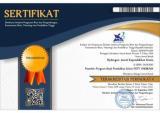The Effect of Concentration of Titanium Dioxide Nanoparticles on Their Antibacterial Activity in the Synthesis of Polyurethane Biopolymers
DOI:
https://doi.org/10.33394/hjkk.v11i5.9021Keywords:
synthesis, nanoparticle TiO2, PU, antibacterialAbstract
In the health sector, the use of polyurethane (PU) as a basic material for medical devices still causes problems related to local and systemic infections. One of the most appropriate ways to overcome this problem is to synthesize PU biopolymer with titanium dioxide (TiO2) nanoparticles. The use of nano-shaped materials in this synthesis has many advantages, including being easier to synthesize and being antibacterial. Meanwhile, starch is the result of isolation from banana weevils, where banana weevils are agricultural waste that has not been utilized properly. Particle size and the use of agricultural waste are a form of modification and innovation in PU synthesis, as well as a novelty in the development of this research. In PU synthesis, several characterization techniques are carried out, including polymer tests, namely strain and stress, functional group analysis using (Fourier Transform Infra-Red), and antibacterial tests. Based on the results of the FTIR test analysis, it show that at a wave number of 1724.36 cm-1, the N-H functional group is visible, and the absorption of urethane and TiO2 groups is in the range of 513.07 cm-1. The mechanical properties test shows the strain (28.92 - 21.88% GL) and young's modulus in the interval (5.484-3.268 MPa). The antibacterial test showed that the inhibitory power of test samples A1 and A4 with diameters of 8 mm and 8 mm proved to be very effective in killing E. Coli bacteria, while test samples A1¹, A2¹, A3¹, and A4 were not able to kill E. Coli bacteria. S. Aureus. bacteria. The characterization results show that PU biopolymer can be used as a basic material for making bacterial decontaminant medical devices.
References
Adnan, A., Aneela, S., Sadia, S., Bassem, F. F., Tabinda, R., Ali, B., Nazia, H., Rafi, U.K.,& Fawad Inam. (2022). Novel Antibacterial Polyurethane and Cellulose Acetate Mixed Matrix Membrane Modified with Functionalized Tio2 Nanoparticles for Water Treatment.J Chemosphere. (301), 1-7.
Angiolillo, D.J., Fernandez,O.,A, Bernardo, E., Alfonso, F., Macaya, C., & Bass, T.A. (2007). Variability in Individual Responsiveness to Clopidogrel. Clinical Implications, Management, and Future Perspectives. Journal of the American College of Cardiology. 49 (14), 1505–1516.
Andi Budirohmi., Ahyar,A., Firdaus.,&Paulina,T. (2020). Characterization and TiO2- Catalyzed Degradation of Polyurethane Biopolymer Through Medium Pro Compos. Oriental Journal of Chemistry. (36), 161-165.
Aranguren, M,I., Marcovich,N.E.,& Mosiewicki.M.A.(2015).Mechanical Performance of Polyurethane (PU)-Based Biocomposites. J.Woodhead Publishing Series in Composites Science and Engineering . 465-485.
Baama, K & Sundarjan,M. (2017). Ag/Tio2/Bentonite Nanocomposite for Biological Applications: Synthesis, Characterization, Antibacterial and Cytotoxic Investigations. J. Advanced Powder Technologi. (28), 2265–2280.
Changhua, Y., Can, L., Liang, X., Min N.,& Qi Wang. (2023). Flow-Induced Alignment of Titanium Dioxide Nanorods in Polyolefin Tubes for Use in Catheters. Journal Materials & Design.(233),1-8.
Duan, J.H., Yin,F.,&Jiang,G.S. (2016). Synthesis and Simultaneous Self-Assembly of Novel Antibacterial Polyurethanes. IOP Conf. Sers: Mater. Sci. Eng. (137 01202), 1-5.
Francolini,I.,& PiozziA.(2016). Antimicrobial Polyurethanes for Intravascular Medical Devices. Journal Advances in Polyurethane Biomaterials. (12), 349-381.
Ghazal, K., Reza, B., Ali, P., &Hossein,G. (2020). In Situ Synthesized Tio2-Polyurethane Nanocomposite for Bypass Graft Application: in Vitro Endothelialization and Degradation. Journal Materials Science & Engineering C. (114),1-10.
Husnul, H. (2018). Pengaruh Ion Hg(II) Terhadap Efektivitas Fotoreduksi Ion Cu(II) Terkatalisis TiO2 dalam Limbah Cair Industri Kerajinan Perak di Desa Ungga Kec. Praya Lombok Tengah. Hydrogen: Jurnal Kependidikan Kimia. 01,(16),75-80.
Ioanna,G.A., Maria,M., Sofia, K., Petroula,T.,& Christos,T.(2018).Study of Thermomechanical and Antibacterial Properties of Tio2/Poly (Lactic Acid) Nanocomposites. Materials Today Journal. (5), 27553–27562.
Kuan, N.C., Fitri, N. I.,& Jyh, M,T.(2019). Multifunctional TiO2/polyacrylonitrile Nanofibers for High Efficiency PM2.5 Capture, UV Filter, and Anti-Bacteria Activity. J. Applied Surface Science.(493), 157- 164.
Malik,S.,Syahzad, T., &Waqas, A. (2014). Synthtysesis and Characterization of Flexible and Rigid Polyurethane Foam. Asian Journal of Applied Sciences. (02),701-710.
Nakkabi,A., Moulaki S., Ibnssouda.,& Moh Fahim,F.(2015).Biological Degradation of Polyurethane By A Newly Isolated Wood Bacterium. International Journal of Recent Advances in Multidisciplinary Research 02(02), 222-225.
Nandini, A. P. Geetha, B. H.,& Mahadevappa ,Y. K.(2017).Smart Biopolymers and Their Biomedical Applications. Journal Procedia Manufacturing. (12), 263 – 279.
Nursin.,Laily,N., Imran.,& Rustam, M. (2019). Uji Aktivitas Antibakteri Staphylococcus Aureus dan Salmonella Typhi dari Hasil Mikroenkapsulasi Minyak Atsiri Rogo (Premna Serratifolia Linn). Hydrogen: Jurnal Kependidikan Kimia.02,(07),73-78.
Ping, W., Xiao, Wei, W,, Wen Jie, C.,Yi Tao, T., Yu Wang., Ze, Yu. G., Jie Hu, J. P.,& Xiao, T. (2019). Effect of TiO2 Nanoparticles on the Characteristics of MAO Coatings. International Journal of Electrochemical Science. (14), 9311 – 9325.
Poonsub, T., Chanirkam, W., Wirawan, I., Sunantha, S.,& Chanin, K. (2014). Effect of TiO2 and ZnO on Thin Film Properties of PET/PBS Blend for Food Packaging Applications. J.Energy Procedia.(56),102-111.
Quan, X. N., Tho Truong, N., Nhut Minh, P.,Toan Trong, K.T.,& Viet Van. (2022). A Fabrication of CNTs/TiO2/polyurethane Films Toward an Tibacterial and Protective Coatings. Journal Progress in Organic coatings. (167), 106838.
Razi,A.,& Meryam,S.(2013).TiO2 Nanoparticles As an Antibacterial Agents E.Coli. International Journal of Inovatif Research In Science Enginereng and Technology.(2),35693574.
Raden, R,Ariessanty.,Antoni, P.,& Emilda,P. (2020). Penentuan Nilai Sun Protection Factor (SPF) dan Uji Antibakteri Staphylococcus aureus Ekstrak Daun dan Kulit Batang Tanaman Bangkal (Nauclea Subdita). Hydrogen: Jurnal Kependidikan Kimia.02,(08), 47-57.
Salman, M., Azadeh, A., Hossein, A.K.,& Seyed, H.J.(2021). Improved Surface Properties in Spray-Coated PU/Tio2/Graphene Hybrid Nanocomposites Through Nonsolvent-Induced Phase Separation. Journal Surface and Coatings Technology. (405),106838.
Vignesh, K., Keerthi, M. N., Snehamol, M., John, B., James, E. K., Hugh, G.M.,Barry, J. W., Nigel, S. L.,& Suresh, C. P. (2021). Antimicrobial TiO2 Nanocomposite Coatings for Surfaces, Dental and Orthopaedic Implants. Chemical Engineering Journal.(416),1-19.
Xiao,W., Pin ting, L., Jin cheng, T., Chang jun, W., , Yan Yang., Zhi-li, Z.,& Da-peng, Z. (2021). Different Antibacterial Mechanisms of Titania Nanotube Arrays at Various Growth Phases of E. Coli. Journal Trans. Nonferrous Met. Soc. China. (31), 3821−3830.
Yuemei, C.,Yuanming, D., Yitao, P., Bijun, T., Yikun, S.,& Jiaoning,T.(2016). One Pot Preparation of Silver Nanoparticles Decorated TiO2 Mesoporous Microspheres with Enhanced Antibacterial Activity. Journal Materials Science and Engineering C.(65),27-32.
Downloads
Published
How to Cite
Issue
Section
Citation Check
License
License and Publishing Agreement
In submitting the manuscript to the journal, the authors certify that:
- They are authorized by their co-authors to enter into these arrangements.
- The work described has not been formally published before, except in the form of an abstract or as part of a published lecture, review, thesis, or overlay journal.
- That it is not under consideration for publication elsewhere,
- That its publication has been approved by all the author(s) and by the responsible authorities – tacitly or explicitly – of the institutes where the work has been carried out.
- They secure the right to reproduce any material that has already been published or copyrighted elsewhere.
- They agree to the following license and publishing agreement.
Copyright
Authors who publish with Hydrogen: Jurnal Kependidikan Kimia agree to the following terms:
- Authors retain copyright and grant the journal right of first publication with the work simultaneously licensed under a Creative Commons Attribution License (CC BY-SA 4.0) that allows others to share the work with an acknowledgment of the work's authorship and initial publication in this journal.Â
- Authors are able to enter into separate, additional contractual arrangements for the non-exclusive distribution of the journal's published version of the work (e.g., post it to an institutional repository or publish it in a book), with an acknowledgment of its initial publication in this journal.
- Authors are permitted and encouraged to post their work online (e.g., in institutional repositories or on their website) prior to and during the submission process, as it can lead to productive exchanges, as well as earlier and greater citation of published work.
Licensing for Data Publication
Hydrogen: Jurnal Kependidikan Kimia uses a variety of waivers and licenses, that are specifically designed for and appropriate for the treatment of data: Open Data Commons Attribution License, http://www.opendatacommons.org/licenses/by/1.0/ (default) Other data publishing licenses may be allowed as exceptions (subject to approval by the editor on a case-by-case basis) and should be justified with a written statement from the author, which will be published with the article.










